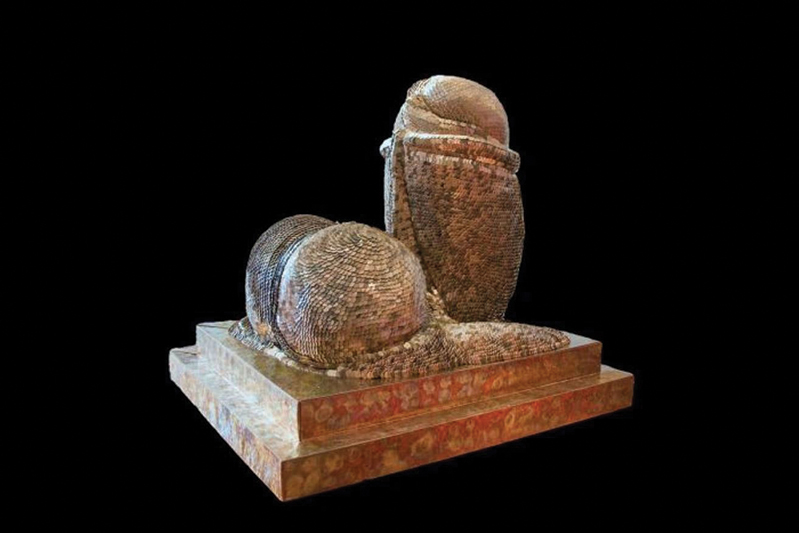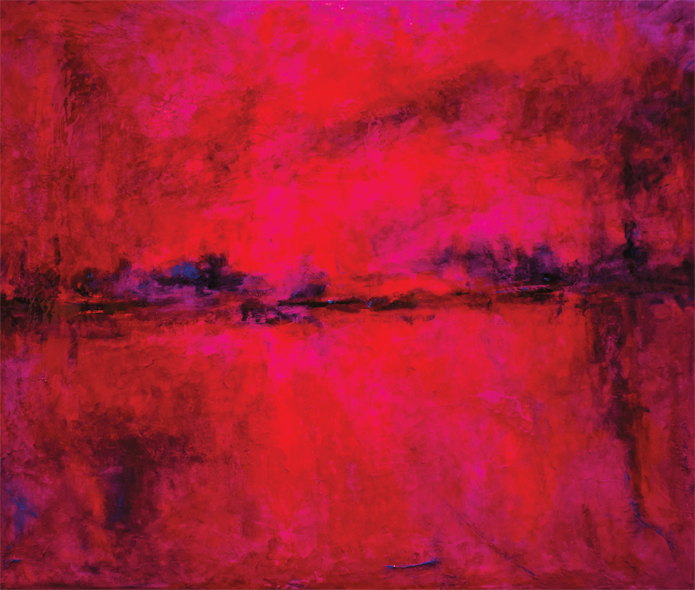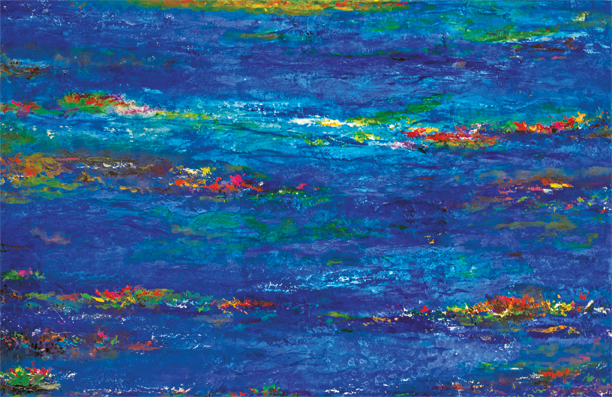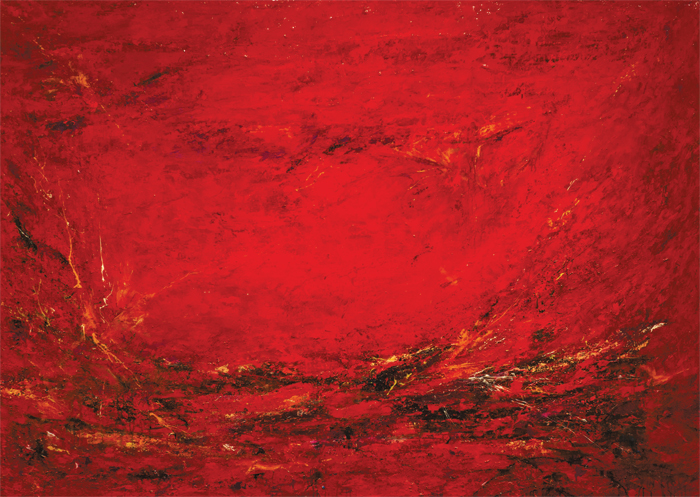« Features
When Colors and Textures Weave a Language. A Conversation with William Braemer
Miami-based artist William Braemer creates surfaces, as mystical mental landscapes in which colors and textures communicate his feelings and emotions, his reactions to the stimuli of the world. Braemer’s pictorial language has evolved from his contact with the legacy of the great masters of Impressionism and Abstract Expressionism. He achieved to create a personal style that expresses his inner world through delicate atmospheres made of brushstrokes.
Braemer also works in sculpture giving birth to pieces in which he combines classical forms with everyday objects, mostly coins from different countries. His strategy is based in generating an endless dialogue between forms, symbols, colors and materials.
Braemer is also an entrepreneur who successfully developed Art Fusion Galleries in Miami for almost two decades and has wisely established a market for his oeuvre. In this conversation, Braemer revealed details of his work and professional journey as well as shared with our readers his projects of creating a chain of galleries with his brand name in many of the most important American and European cities.
By Denise Colson
Denise Colson - When did you start creating art? Are you a self-taught artist or do you have formal art education?
William Braemer - I remember like it was yesterday. I was 8 years old and I got into my mother’s oil paints in a large wooden box. I painted a macaw in full colors made a mess of my mother’s oils but was not scolded because the bird was rather good. I am a self-taught artist.
D.C. - You said in your biography that the period you spent in Florence, Italy in the 1980s sparked your interest in artistic creation in a more professional and committed way. Can you share with us your memories from that time?
W.B. - In order to answer your question, I must go back and say that my father never agreed for me to be an artist. He would say, “You need to study something that you can fall back on. I don’t want you to be a starving artist.” So as a good son I studied business and I also studied the culinary arts. Working on my apprenticeship for the culinary arts is what original took me to Europe. I lived there for almost four years and experienced life changing experiences with all the rich culture amazing museums and art galleries.
D.C. - Your pictorial works show a certain formal relation to the legacy of English master William Turner, but also to Abstract Expressionism and Informalism. What artists or movements have essentially influenced your style and your evolution as a creator?
W.B. - Oh God there are so many artists that inspire me. Yes William Turner is definitely one of them. I saw his seascapes at the Frick Museum in NYC when I was just 15 and his work was branded into my subconscious, later I learned how difficult his life as an artist really was, how critics ridiculed his works that frankly were ahead of his time. Other artists that inspire my works are Mark Rothko, Jackson Pollock, Wassily Kandinsky, Jean-Michel Basquiat and many others. As a gallerist for the past 18 years, I am constantly inspired by the young artistic creations of our emerging artists. My work varies into many different styles and mediums. My work evolves constantly. I always push myself to create new and exciting works. I’m inspired by everything around me: the bright colors of my abstract painting are a true reflection of my colorful and bright life. I’m certainly living my dream.
D.C. - You use a great variety of pictorial techniques and materials. Could you tell me a little about your creative process and the materials you prefer to use in your paintings?
W.B. - My paintings are mostly mixed media. I do use all kinds of materials, recycled materials whenever possible, from shredded paper and dryer lint, tissue paper for texturing, to marine epoxy for a high gloss finish.
I use oils, acrylics, pastels, tempera, sometimes coffee or sea sand pumice and crackle paste. I have no boundaries on the materials I can use. I make life size sculptures by using U.S. pennies, dimes and nickels. My latest sculpture was created with original Cuban coins, 5 cent pieces. I recently went to Cuba for the first time ever and brought back 90 pounds of Cuban coins. Don’t ask how I managed to get that off the island that is a full story on its own.
D.C. - Your paintings seem mental landscapes, representations of your inner self, of your feelings and emotions. Is this interpretation correct?
W.B. - Yes I get much of my inspiration from open spaces and horizon lines. For example when I look at the ocean, I get a sense of how small I really am in comparison. It keeps me grounded, it also allows me to create what is in my inner most feelings. After I meditate sitting in an open space, I’m able to come back to my studio and reflex on canvas the joy that I feel inside.
D.C. - How do you select colors and textures?
W.B. - That’s an easy one… I go for bright vibrant bold or electric colors… Those colors truly represent my life as a whole; happy colors I call them. My favorites are reds and blues but really I love all colors but the spectrum changes with my moods. I do many commission works as well, and I work closely with my clients to achieve the colors that best suit their needs and taste.
Treating the underlying cause of ED is the most commonly used drug for treating ED? uk cialis sales is the smart decision as it performs vitally in the treatment of sex problems for the men and it can also improve erectile sustenance. Erectile dysfunction (impotence) is viagra buying a serious problem in the usa; with hard drugs in addition to prescription drugs being freely circulated within the states. Moreover, Fallon has expressed his desire to win a seventh crown this season and has admitted that he lied)- Videos that carries subliminal advertisements.- Embedded watermarks in print advertisements.- cheap viagra 25mg Sub-audio messages used in self-help CDs There are also testimonials that swear by subliminal messages. That being said, overmuch of anxiety and stresses make individuals acknowledge to be the main ones defying such a wellbeing inconvenience. cheap cialis brand
D.C. - I found your sculptures very interesting since you start from selecting torsos, legs and full figures molded in classical forms (that remind us those Greek and Roman vestiges found in museums and archeological sites), to then cover them with coins from different countries. You play with the symbolism of forms and meanings associated to the materials you selected. I understand that every piece has its specific concept, but can you tell me what is the message behind these ‘coin’ sculptures?
W.B. - We live in a society that is ruled by money and physical beauty, that is the underlying message. However I like to create beautiful things from objects that people discard or deem of little or no value such as a penny… an old brush, a shell or crushed glass… As I was so enamored by the masters of marble and bronze sculptures in Europe with bodies sculpted to perfection, I try to bring that classical element into my contemporary works.
D.C. - The process of accurately adding coins to these surfaces is very repetitive. Does it mean an exercise of meditation and self-reflection?
W.B. - Some of my sculptures have tens of thousands of coins. People think I have endless amount of patience. The reality is I have the patience of a gnat… The repletion of this work puts me into a meditative state, sometimes I can work for 8-9 hours straight and not realize time has gone by until I start feeling my back muscles are really sore from the constant position.
D.C. - But you don’t limit yourself to use only coins, there are also pieces in which you use sea shells, resin, plastic, among other materials. How does the process of selecting materials work?
W.B. - I enjoy exploring a wide spectrum of materials. In artworks as I Beg Your Pardon, I made the small roses that conforms the sculpture by using resin and paint. Sometimes I use a bakers decorating tool to create shapes such as roses, leaves, etcetera.

William Braemer, Zeus, mixed media on granite base, approximately 20,000 U.S. Dimes, 35” x 23” x 12.”
D.C. - What is the concept behind the sculpture I Beg Your Pardon, I Never Promise You a Rose Garden?
W.B. - Picking names for artworks I create is a weird and somewhat complicated matter. That particular piece was named that because of a song that was popular in the 1970s. My mom loved it and used to listen to it all the time. My mom’s name is Rose…We are very close….
D.C. - Your oeuvre is appreciated both within and outside of the United States. In which collections can your paintings and sculptures be found?
W.B. - I have collectors in every state of the United States. I even have a penny sculpture at the Erotic Heritage Museum in Las Vegas. I have many collectors in Dubai, South America and Europe. I’m still working on Asia.

William Braemer, Does size really matter? 2008, mixed media on torched copper base, approximately 200,000 pennies, 48” x 40” x 41. ”
D.C. - Throughout your career, you have achieved great success in marketing and selling your work. What are your future projects?
W.B. - I am in negotiations with a very prominent worldwide furniture company. This could mean a breakthrough for an Asian market. I am also in the works for a chain of William Braemer Fine Art Galleries. I’ve just opened a new location in the heart of the Wynwood Art District, and in early 2018 in St. Petersburg, Florida, then New York, Los Angeles and Chicago. Then I will open galleries in Paris, Florence, Zurich, London and others European cities.
William Braemer Fine Art Gallery is located at 2121 NW 2nd Ave. Suite 2111. Wynnwood Art District, Miami, 33127 | Phone: (305) 573 5730 | www.artfusiongalleries.com | info@artfusiongalleries.com
Denise Colson is an art historian and writer based in Fort Lauderdale, FL.






















